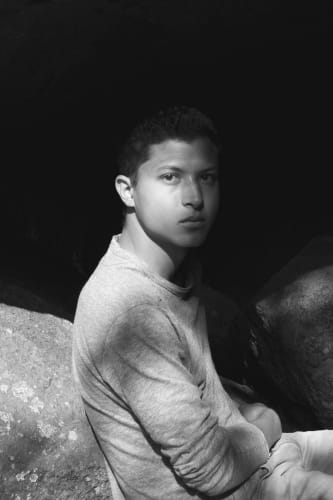The current group exhibition 'Trust in Mortals' explores the complexities of the human experience through the eyes of four meticulous and uniquely different observers; from Harms' steel-like relationships to his subjects and Moritz's immersive empathy, to the technical constructs of Robles de Medina's seemingly emblematic paintings and Touborg's near-futuristic investigations into the relationship between humankind, nature and technology. To gain some valuable insight into Medina's practice and to get his thoughts on the exhibition, we asked a few questions.
The exhibition explores the complexities of the human experience on both a macro and micro level; where do you feel your work fits on this spectrum? The work I do is probably 99% internal and private. There are moments that my entire life revolves around it, and grant me both immense comfort and connection, as well as the opposite which for me is fear around deadlines, shipping, and financial pressures. The viewer doesn't necessarily see any of this, so in a strange way, I think that also lends itself to a more general reading. In terms of how I think about representation, I really want for the images I create to embody something empowering, and seductive, through a sort of queer totemic. What I mean by that, is a sort of combination of queer intuition, which I can't quantify or define, and a totem, which is a symbol-something fully recognizable and familiar. My hope for the part of my work visible to the viewer, is to function on both a micro and a macro level insofar it considers the human experience more broadly.
How important do you think narrative and context is to the perception of your work? Narrative is to my work, what the front door is to a house. For visitors, it's probably how they enter the space, and then might find that the interior space looks very different from the impression they had outside. Context on the other hand, is an entirely different thing to me. It's kind of like, so big that we don't even know it, right? Like I know I live on planet earth, and I choose to believe it's round, but couldn't tell you from my own observation that it definitely is rounds, in fact that it is an irregularly shaped ellipsoid. I was listening to a podcast about Bloghouse recently and realized there's a whole cultural era (and period in contemporary art) that I remember vividly as an adult, and actively participated in sort of intuitively, without realizing the actual mechanisms that were shaping many people's and my own relationship to art during that time. It's only ten years later that we realize, oh that was a period when many people discovered and shared art and music over blogs, and that had huge social and artistic consequences and ripples we are only now able to comprehend, because we're comparing it to what that context has morphed into, which is the now. This is a very long winded way of saying that, I don't pretend to fully understand the fullness of the context I make work in, I'm often forced to respond more directly to challenges at hand, I just have to think more practically I guess, but that's also part of the context.
Is there a work from another artist in the exhibition that resonates with you and if so, how? I haven't seen the show in personal unfortunately, so I acknowledge my impression of the work is limited. That said, just from a graphic digital impression, I really like Bendix Harms "Das Mamonböse ist bösche." I find it just very striking in a visual sense, in the way that 50s cartoons are striking and communicate a single gesture in its most extreme form, with relatively few tools, in this case a simple silhouette, and three main colors. There's also something about the combination of kind of buttery wet paint that's been scratched into that I enjoy here, in conjunction with the choice of colors, it enhances something menacing about the image.
Should we put our trust in mortals? Apprehensively.
11 October 2022


